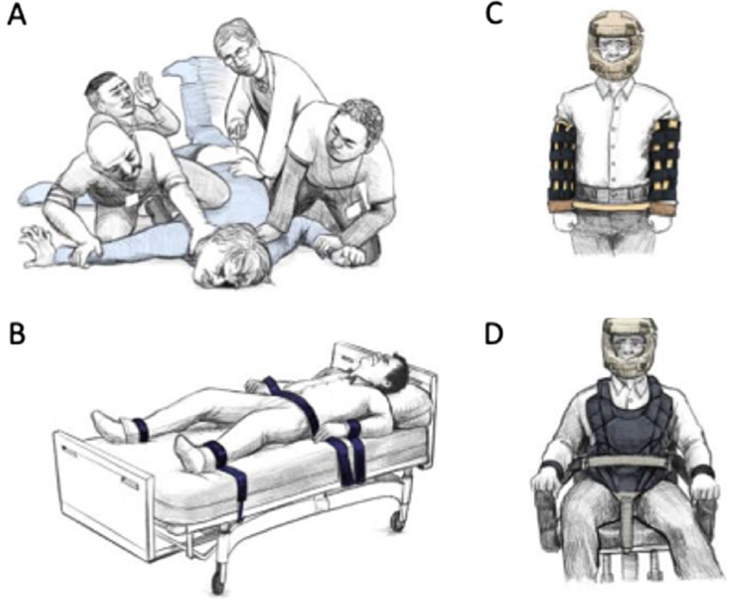A nurse is caring for a client who is in physical restraints. Which of the following actions by the client indicates the restraints can be discontinued?
The client apologizes for their prior behavior.
The client remains in control of their actions.
The client asks to be released from the restraints.
The client signs a behavioral contract.
The Correct Answer is B
Choice A reason:
An apology from the client for their prior behavior, while it may be a positive step towards recovery, does not necessarily indicate that they have regained control over their actions or that they no longer pose a risk to themselves or others. The decision to discontinue restraints should be based on current behavior and risk assessment rather than past actions.
Choice B reason:
The primary goal of using physical restraints is to prevent harm to the patient or others when less restrictive interventions are not effective. If the client demonstrates control over their actions, it suggests that they are no longer at immediate risk of harm, and therefore, discontinuing restraints could be considered³⁴⁵. This aligns with guidelines that advocate for restraint use to be continually assessed and reduced or discontinued as soon as possible.
Choice C reason:
While a request to be released from restraints indicates a desire for freedom, it does not provide enough information about the client's current mental state or risk of harm. The healthcare team must assess whether the client's condition has improved to a point where restraints are no longer necessary.
Choice D reason:
Signing a behavioral contract is a positive step towards establishing trust and setting expectations for behavior. However, it is not an immediate indication that the client can safely have restraints removed. The effectiveness of such contracts depends on the individual's ability to understand and adhere to the agreed-upon behaviors.

Nursing Test Bank
Naxlex Comprehensive Predictor Exams
Related Questions
Correct Answer is C
Explanation
Choice A reason:
Telling a client to focus on themselves for a change may come across as dismissive and does not address the underlying feelings of hopelessness. It is important for the nurse to acknowledge the client's feelings and provide support rather than suggesting a shift in focus without understanding the root cause of their distress.
Choice B reason:
Asking the client why they feel like things will never work out can be a useful way to explore their thoughts and feelings. However, it may not be the most immediate concern if the client is experiencing severe hopelessness or suicidal ideation. The nurse should prioritize assessing the client's safety and risk of self-harm.
Choice C reason:
Asking if the client has been thinking about harming themselves is crucial in assessing their safety. Suicidal ideation is a serious concern, and it is important for the nurse to directly address this issue to determine if the client is at risk of self-harm. This response shows that the nurse is taking the client's feelings seriously and is concerned about their well-being.
Choice D reason:
Suggesting an antidepressant might make the client feel better can be helpful in the long term, but it does not address the immediate emotional distress the client is experiencing. Medication can be part of a treatment plan, but the nurse should first ensure the client's immediate safety and provide emotional support.
Correct Answer is C
Explanation
Choice A reason:
Long hallways can be challenging for clients with dementia due to potential confusion and disorientation. However, they do not pose a direct physical risk. Long distances might require more supervision and assistance, but they are not inherently dangerous.
Choice B reason:
Having the bed in a low position is generally a safety measure to prevent falls. For clients with dementia, this can be beneficial as it reduces the risk of injury if they attempt to get out of bed unassisted. Therefore, this is not considered a risk factor.
Choice C reason:
An area rug in the room can be a significant tripping hazard for clients with dementia. Dementia can affect a person's gait and balance, making them more prone to falls. Loose or uneven rugs can easily cause trips and falls, leading to potential injuries. This is why the presence of an area rug is identified as a risk.
Choice D reason:
Having locks on outside doors is a safety measure to prevent clients with dementia from wandering off and getting lost. Wandering is a common behavior in dementia patients, and locks can help ensure their safety by keeping them within a secure environment. This is not considered a risk but rather a protective measure.
Whether you are a student looking to ace your exams or a practicing nurse seeking to enhance your expertise , our nursing education contents will empower you with the confidence and competence to make a difference in the lives of patients and become a respected leader in the healthcare field.
Visit Naxlex, invest in your future and unlock endless possibilities with our unparalleled nursing education contents today
Report Wrong Answer on the Current Question
Do you disagree with the answer? If yes, what is your expected answer? Explain.
Kindly be descriptive with the issue you are facing.
